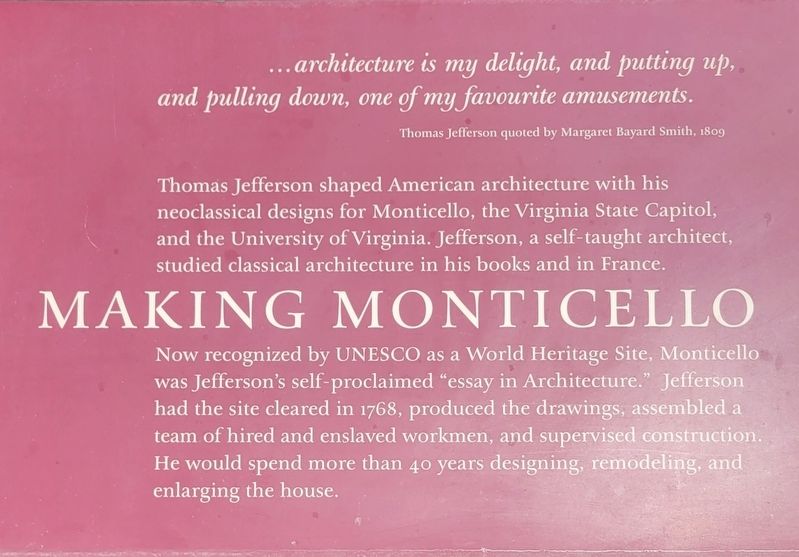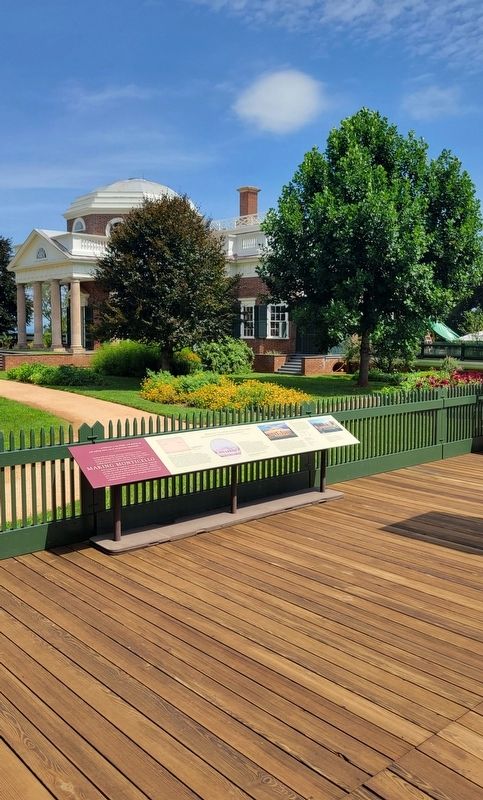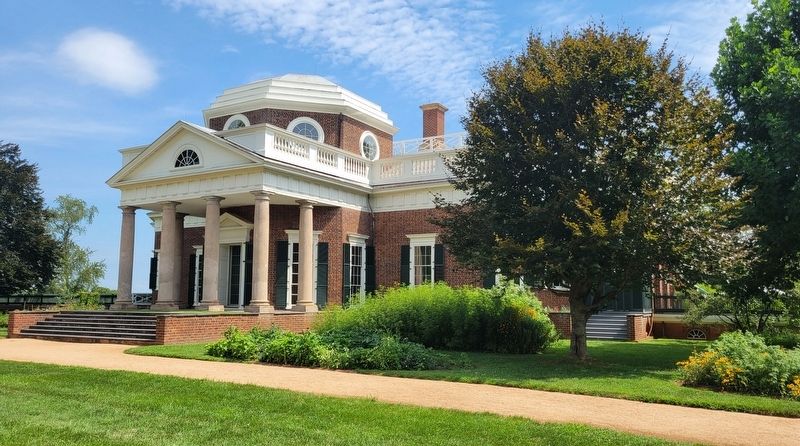Near Charlottesville in Albemarle County, Virginia — The American South (Mid-Atlantic)
Making Monticello
... architecture is my delight, and putting up, and pulling down, one of my favourite amusements.
Thomas Jefferson quoted by Margaret Bayard Smith, 1809
Thomas Jefferson shaped American architecture with his neoclassical designs for Monticello, the Virginia State Capitol, and the University of Virginia. Jefferson, a self-taught architect, studied classical architecture in his books and in France.
Now recognized by UNESCO as a World Heritage Site, Monticello was Jefferson's self-proclaimed "essay in Architecture." Jefferson had the site cleared in 1768, produced the drawings, assembled a team of hired and enslaved workmen, and supervised construction. He would spend more than 40 years designing, remodeling, and enlarging the house.
The First Monticello
Jefferson began to design and build Monticello in 1770, before his marriage to Martha Wayles Skelton. Built in a strict neoclassical style with double-storied porticos on opposite sides, the ambitious design was derived from the work of Italian Renaissance architect Andrea Palladio (1508-80). Even though evidence suggests the house was never finished, a French visitor remarked in 1782 that "Mr. Jefferson is the first American who has consulted the fine arts to know how he should shelter himself from the weather." The early plans included two service wings that were completed in 1809.
While at Paris, I was violently smitten with the hotel de Salm, and used to go to the Thuileries almost daily to look at it.
Thomas Jefferson, 1787
Inspiration
Jefferson's years in Paris as the United States Minister to France (1784-89) marked a radical turning point in his architectural education. Whereas previously, Jefferson's inspiration had come from books, in France, he saw neoclassical public buildings and private houses, studied Roman temples, and established relationships with architects and artists. Soon after his return from France, Jefferson decided to expand and transform Monticello.
Remodeling Monticello
In 1796, Jefferson expanded Monticello from eight to 21 rooms. He retained five first-floor rooms, but widened the footprint and added a second-floor mezzanine to create four floors, including the cellar. As a final flourish, he crowned the building with the earliest residential dome in the United States. After 40 years of building and remodeling, the house was essentially completed in 1809, although the West Portico columns did not replace temporary tree trunks until 1823.
Monticello II Statistics
Dimensions: Main House
110' long, 87'-9" wide, 44'-7" high
Floors: 4
Rooms: 21
Square Feet: about 11,000
Bedrooms: 12
Privies: 4
Closets: 1
Wings
During the remodeling, enslaved laborers dug the foundations for one of Monticello's notable features: the "wings." Raised, L-shaped terraces extended from either side of the house over the submerged kitchen, smokehouse, dairy, carriage bays, stables, and slave quarters. The wings preserved the mountaintop views and eliminated distracting service buildings, while providing sheltered passageways between the house and work spaces.
At the end of each wing is a small pavilion with living or office space above, and a work space below. The South Pavilion was the first brick structure built on the mountaintop, while its counterpart, the North Pavilion, was constructed over 30 years later.
Crowded Household
In 1826, Monticello housed at least 14 people, spanning four generations, aged two months to 83 years old. Short- and long-term visitors further crowded the house; its passageways also had to accommodate the traffic of enslaved servants.
(Captions):
Thomas Jefferson's initial concept for Monticello, probably drawn in early 1771.
Massachusetts Historical Society
Vue de la Maison de M le Prince de Salm, Située a la Grenouillere engraved by Laurent Guyot, 1787-89.
Thomas Jefferson Foundation at Monticello
View of the West Front of Monticello and Garden
by Jane Braddick Peticolas, 1825.
Thomas Jefferson Foundation at Monticello
Topics and series. This historical marker is listed in these topic lists: African Americans • Architecture. In addition, it is included in the Former U.S. Presidents: #03 Thomas Jefferson series list. A significant historical year for this entry is 1809.
Location. 38° 0.593′ N, 78° 27.149′ W. Marker is near Charlottesville, Virginia, in Albemarle County. Marker can be reached from Monticello Loop, 0.4 miles north of Thomas Jefferson Parkway (Virginia Route 53), on the left when traveling north. Marker is located beside the South Pavilion on the southwest side of Monticello. Touch for map. Marker is at or near this postal address: 931 Thomas Jefferson Parkway, Charlottesville VA 22902, United States of America. Touch for directions.
Other nearby markers. At least 8 other markers are within walking distance of this marker. South Pavilion (here, next to this marker); A Presidential Scandal: (a few steps from this marker); Sally Hemings's Life (a few steps from this marker); Sally Hemings (a few steps from this marker); Mulberry Row (within shouting distance of this marker); Smokehouse/Dairy (within shouting distance of this marker); The Levy Legacy (within shouting distance of this marker); Vegetable Garden (within shouting distance of this marker). Touch for a list and map of all markers in Charlottesville.
Credits. This page was last revised on August 18, 2023. It was originally submitted on August 18, 2023, by Bradley Owen of Morgantown, West Virginia. This page has been viewed 80 times since then and 19 times this year. Photos: 1, 2, 3, 4. submitted on August 18, 2023, by Bradley Owen of Morgantown, West Virginia.



